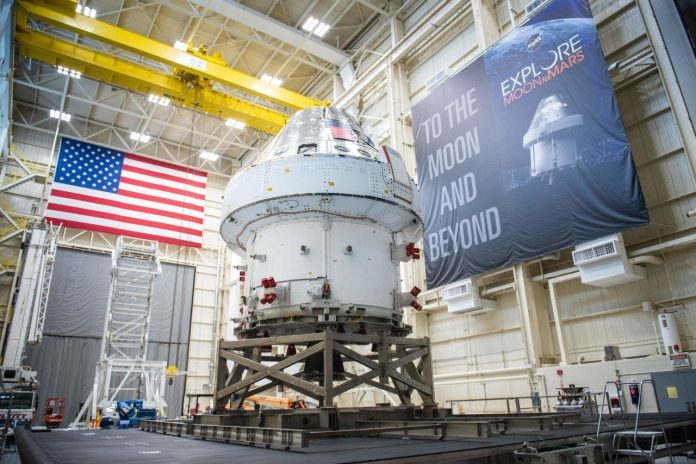US aerospace and weapons manufacturer Lockheed Martin has appointed NEC Corporation to help it to apply artificial intelligence (AI) and machine learning (ML) for system diagnostics in the production and operation of spacecraft. At the same time, plans are emerging for the company to raise a satellite-based 5G network to remote control its global weaponry.
The new work with NEC covers applications on NASA’s new Orion spaceship, built by Lockheed Martin and transferred to NASA in January, to take astronauts into deep space, including for the Artemis mission to the Moon and Mars. The latter, around satellite 5G for military systems, follows the appointment of former American Tower boss James Taiclet and the award of a $188 million contract with the new Space Development Agency (SDA) to launch a satellite-based wideband cellular network.
Lockheed Martin and NEC have signed a ‘joint collaboration agreement’ to extend the US firm’s existing usage of NEC’s System Invariant Analysis Technology (SIAT) system in early production testing and operational scenarios. Lockheed Martin has now integrated the NEC software into its own T-TAURI time series telemetry analytics platform. The intention is to drive “proactive anomaly detection” during the design, development, production, and testing of spacecraft.
The same AI and ML applications will be used in space missions, as well, including for real-time analysis of the Orion spaceship during the Artemis 3 mission, the third flight of the reusable Orion spacecraft, scheduled for 2024, as the second crewed mission of the Artemis programme, the first crewed lunar landing since Apollo 17 in 1972, and a dry-run for a Mars mission sometime after 2028.
The SIAT analytics engine uses data from IoT sensors — placed in sundry industrial systems, including in computer systems, power plants, factories, and buildings — to “automatically detect inconsistencies and prescribe resolutions”. Integration with the T-TAURI system will provide a “holistic understanding of a system” and create a “foundational system for other advanced technologies like system-level digital twins”, said NEC.
Lockheed Martin has used the SIAT system to analyze high volumes of data during testing of the Orion at the Kennedy Space Center, before handing ownership to NASA’s Exploration Ground Systems (EGS) team. The pair said that, within one four-hour period, T-TAURI and SIAT built a model of the vehicle’s normal operations from nearly 150,000 sensors to establish over 22 billion logical relationships for analysis.
NEC commented: “The resulting models can be used to monitor all future tests of subsequent vehicles to compare expected and irregular behavior to analyze consistency and aid in regression analysis. Without these advanced AI and ML tools, it would be impossible for a single engineer to analyze massive amounts of data manually at the speed needed to analyze the data in its entirety.”
The companies are also to sign a licensing agreement with a multi-year option, they stated. AI and ML processing of IoT data will be used, also, for ground station support for customer satellite operations as well as expanding the application for human-rated systems to demonstrate an increase in speed of anomaly detection and root cause analysis on missions.
Rick Ambrose, executive vice president at Lockheed Martin Space, said: “The power of AI is leveraged across our entire enterprise, and with a trusted partner like NEC, we gain the resources to expand its abilities at scale across our internal operations. By proactively analyzing telemetry data we are able to deliver our systems even faster and streamline the work that our employees do every day.”
Motoo Nishihara, executive vice president and chief technology officer at NEC Corporation, said: “SIAT… provides value to Lockheed Martin as it addresses not only the development of complex systems, but also the uniqueness of deep space exploration. Together, we are committed to strengthening our solution and finding new ways to apply this technology.”
Meanwhile, Lockheed Martin is putting a major focus on 5G technologies, as reported in Aviation Today, and variously. The firm appointed former Taiclet as chief executive in June last year. Since then, Taiclet has spoken in vague terms about building 5G capabilities, under the project name 5G.mil, to connect and remote-control its weapons and claim military advantage for the US.
In October, on an earnings call, he explained: “We’re talking… about how [to go] to war on a battlefield and bring with you… the throughput of data, the latency benefit, and the ability to do software defined networks, and manage spectrum dynamically on a battlefield.” But the plan is not for Lockheed Martin to engage, for these ends, in terrestrial 5G networks; instead, it is looking to launch 5G into space, to cover its war efforts from low earth orbiting (LEO) satellites.
It will use the $188 million contract with the SDA to launch “tens of satellites with optical inter-satellite links capable of sending and receiving wideband data to and from other space vehicles and ground stations,” according to the terms of their deal. Taiclet said on the October call it will build “an interoperable, connected and secure mesh network of satellites that links ground, sea, and air capabilities to sensors in space”.

